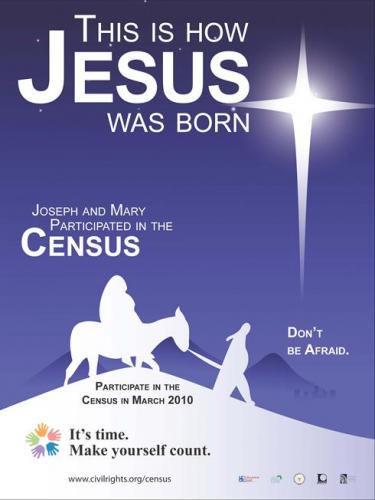 It's a cliche for a reason – sometimes a picture is worth a thousand words. Suffice to say, I quickly understood what this Washington Post story was about before I even read it thanks to the picture included with the story (and reproduced here to the right). It's about a poster produced by the National Association of Latino Elected Officials (NALEO) and distributed to some 7,000 churches in an effort to get Hispanics to increase participation. As you can see, the poster has stirred a bit of controversy.
The story is perfunctory and does a fine job of noting the objections of religious leaders to the poster but it does a really bad job of summing up the nature of the controversy, which has a lot to do with whether illegal immigrants should participate in the census. In fact, the Post story doesn't even mention the word "immigrant." Aside from that, though, there were two religion-related things of note. The first is this:
It's a cliche for a reason – sometimes a picture is worth a thousand words. Suffice to say, I quickly understood what this Washington Post story was about before I even read it thanks to the picture included with the story (and reproduced here to the right). It's about a poster produced by the National Association of Latino Elected Officials (NALEO) and distributed to some 7,000 churches in an effort to get Hispanics to increase participation. As you can see, the poster has stirred a bit of controversy.
The story is perfunctory and does a fine job of noting the objections of religious leaders to the poster but it does a really bad job of summing up the nature of the controversy, which has a lot to do with whether illegal immigrants should participate in the census. In fact, the Post story doesn't even mention the word "immigrant." Aside from that, though, there were two religion-related things of note. The first is this:
Luke 2:1-4 says Jesus was born during a census ordered by Caesar Augustus. Although historians question the accuracy of the account, Luke stated that everyone had to return to his ancestral town to be registered for taxes and that Joseph and Mary left Nazareth for Bethlehem.
Emphasis mine. Really? I wonder whether that qualifying phrase is really all that necessary, but even so – what about the accuracy of the account is it that historians dispute? Jesus' birth? That there was a census? That is was ordered by Caesar Augustus? That they had to return to Bethelem? That the purpose of the census was to register for taxes? The lack of specificity there is dismaying. And what about the historians that don't question veracity of the account? Historians don't think as a block, so either get specific about the objections of particular historians or at the very least write it as "Although some historians question..."
The other aspect of the story that seemed worth looking at was near the end where, after quotes from a number of religious leaders objecting to the poster, we get this:
Marcus Borg, a historical Jesus scholar at Oregon State University, said the narrative of Jesus's birth is often used for secular purposes.
"Take Christmas cards, if they say, 'Peace on Earth,' and don't say anything specifically Christian," he said. "I can't imagine why anyone would take issue with the poster on grounds of irreverence or blasphemy."
What Borg says really demands some explanation and clarification. The assertion that the phrase "Peace on Earth" isn't "specifically Christian" probably had a lot of people scratching their heads when they read that – starting with one of my colleagues. While the sentiment may seem universal, the phrase "peace on earth" as a Christmas wish comes from Luke chapter 2, already noted above as being a Nativity account: "And this shall be a sign unto you; Ye shall find the babe wrapped in swaddling clothes, lying in a manger. And suddenly there was with the angel a multitude of the heavenly host praising God, and saying, Glory to God in the highest, and on earth peace, good will toward men." As to whether that Christian desire for peace on earth was meant is understood to be anodyne enough to be agreeable to all men, I can only quote Jesus himself in Luke 12:51: "Suppose ye that I am come to give peace on earth? I tell you, Nay; but rather division."
To be fair, perhaps Borg meant to say that it wasn't explicitly Christian, in that the phrase doesn't mention Jesus or – at least when taken out of context – explicitly assert the primacy of the Christian faith over others and thus might be considered not especially offensive to non-Christians. On the other hand, I'm not sure what that would have to do with the poster, which is headlined "This is how Jesus was born." The whole quote seems somewhat out of place. If Borg's remarks are to be included, some context and clarification are in order.
